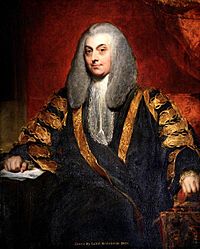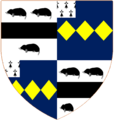John Freeman-Mitford, 1st Baron Redesdale facts for kids
Quick facts for kids
The Lord Redesdale
|
|
|---|---|

Sir John Mitford by Sir Thomas Lawrence
|
|
| Speaker of the House of Commons of the United Kingdom |
|
| In office 11 February 1801 – 9 February 1802 |
|
| Monarch | George III |
| Preceded by | Henry Addington |
| Succeeded by | Charles Abbot |
| Lord High Chancellor of Ireland | |
| In office 1802–1806 |
|
| Monarch | George III |
| Prime Minister | |
| Preceded by | The Earl of Clare |
| Succeeded by | George Ponsonby |
| Personal details | |
| Born |
John Mitford
18 August 1748 London, England |
| Died | 16 January 1830 (aged 81) Batsford Park, Gloucestershire, England |
| Spouse |
Lady Frances Perceval
(m. 1803; died 1817) |
John Freeman-Mitford, 1st Baron Redesdale (born 18 August 1748 – died 16 January 1830) was an important English lawyer and politician. He was also known as Sir John Mitford for a time. He served as the Speaker of the House of Commons from 1801 to 1802. After that, he became the Lord Chancellor of Ireland from 1802 to 1806.
Contents
Who Was John Freeman-Mitford?
John Mitford was born in London, England. He was the younger son of John Mitford and Philadelphia Reveley. His older brother, William Mitford, was a well-known historian.
Early Life and Education
John went to Cheam School when he was young. After school, he decided to study law. He began his law studies at the Inner Temple in 1772. He officially became a lawyer, or was "called to the bar," in 1777.
Becoming a Lawyer and Politician
After becoming a barrister (a type of lawyer) in 1777, John Mitford wrote an important book. It was called A Treatise on the Pleadings in Suits in the Court of Chancery by English Bill. This book was very popular and was printed many times in England, Ireland, and America. In 1789, he became a King's Counsel, which is a special title for experienced lawyers.
In 1788, John Mitford became a Member of Parliament (MP) for the area of Bere Alston in Devon. In 1791, he helped pass a law to give more rights to Roman Catholics. This was a big step, even though he himself was a strong Anglican (a member of the Church of England).
In 1793, he became the Solicitor-General for England. This is a senior legal role for the government. At this time, he also received the title of Knight Bachelor, which meant he was called "Sir John Mitford." Six years later, he became the Attorney General, another very important legal position. He also became an MP for East Looe in Cornwall.
In 1794, John Mitford was chosen to be a Fellow of the Royal Society. This is an honor given to people who have made great contributions to science.
Important Roles: Speaker and Lord Chancellor
In February 1801, John Mitford was chosen to be the Speaker of the House of Commons. This means he was in charge of leading discussions and keeping order in the main part of the British Parliament. He also joined the Privy Council, a group of advisors to the King.
Exactly one year later, he was given another big job: Lord Chancellor of Ireland. This was the highest legal position in Ireland at the time. When he took this role, he was also given a special title, becoming Baron Redesdale. This meant he was now a peer and could sit in the House of Lords.
Lord Redesdale was not popular in Ireland because he strongly opposed Catholic Emancipation. This was a movement to give more rights to Catholics. He also faced criticism from some people, including a senior judge named Robert Johnson. In February 1806, he was removed from his position when a new government was formed.
Even though he left his official government job, Lord Redesdale remained active in politics. He was a busy member of the House of Lords. In 1813, he helped pass laws to help people who were in debt. He also spoke out against some popular ideas for reform.
Later Life and Family
Lord Redesdale married Lady Frances Perceval in 1803. She was the daughter of John Perceval, 2nd Earl of Egmont, and the sister of Prime Minister Spencer Perceval. In 1809, he added the name Freeman to his own. This was because he inherited land from a relative. Lady Redesdale passed away in August 1817.
Lord Redesdale lived for thirteen years after his wife died. He passed away at Batsford Park in Gloucestershire in January 1830, when he was 81 years old. His only son, John, inherited his title. His son later became the Earl of Redesdale in 1877.
Images for kids



